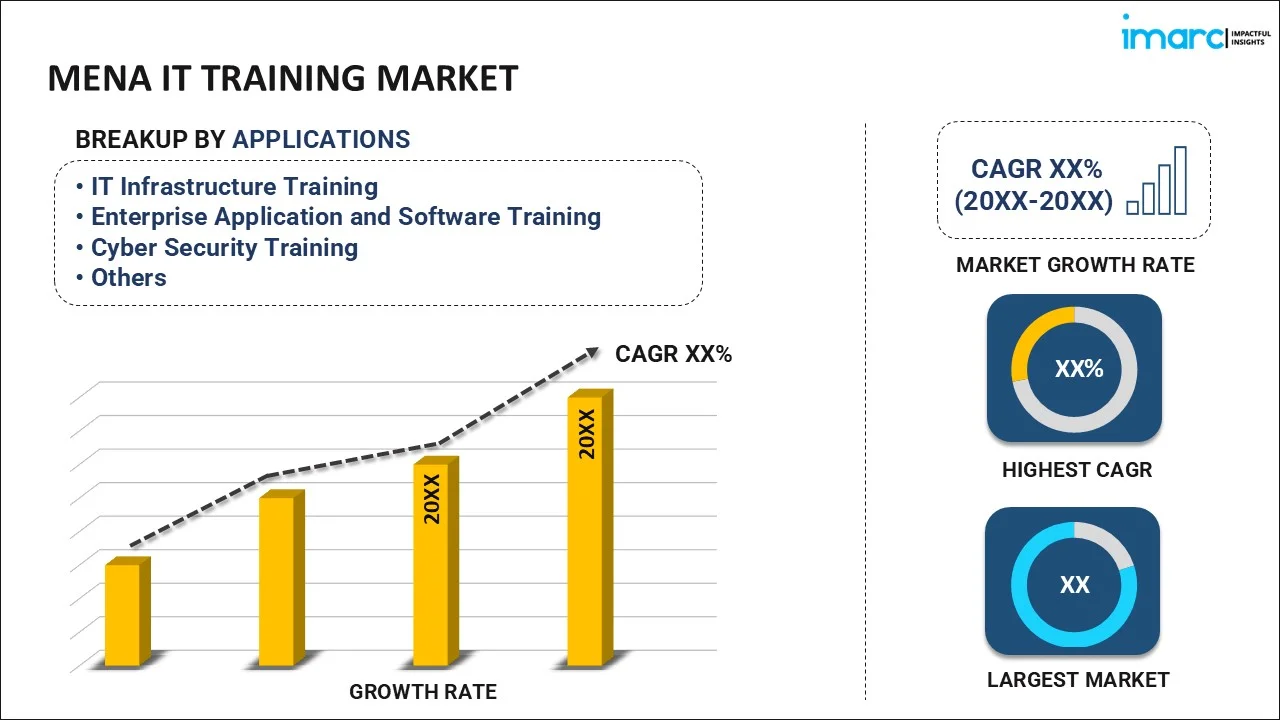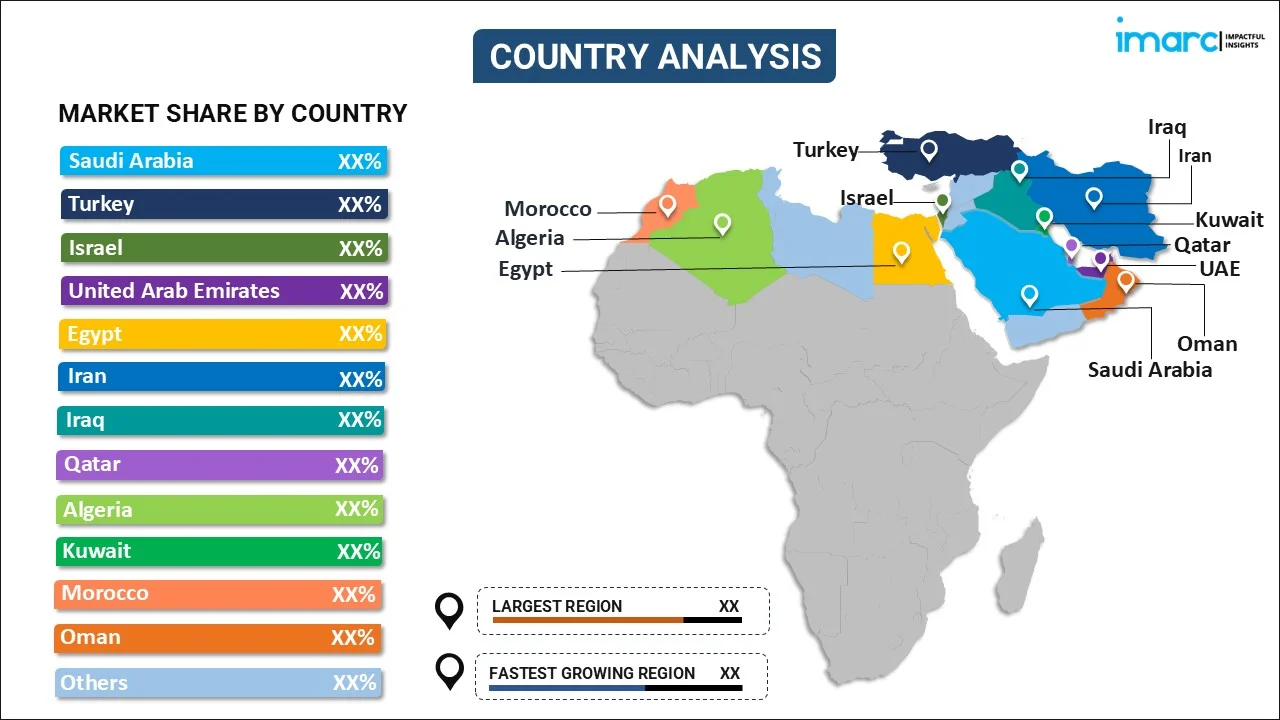
MENA IT Training Market Report by Application (IT Infrastructure Training, Enterprise Application and Software Training, Cyber Security Training, Database and Big Data Training, and Others), End User (Corporate, Schools and Colleges, and Others), and Country 2024-2032
Market Overview:
The MENA IT training market size is projected to exhibit a growth rate (CAGR) of 5.85% during 2024-2032. The increasing government-led initiatives and policies aimed at promoting technology adoption and innovation, the rising investments by businesses in IT infrastructure and solutions, the global technological trends, and the acceleration of remote work are some of the factors propelling the market.
|
Report Attribute
|
Key Statistics
|
|---|---|
|
Base Year
|
2023 |
|
Forecast Years
|
2024-2032
|
|
Historical Years
|
2018-2023
|
| Market Growth Rate (2024-2032) | 5.85% |
IT training is a structured educational process designed to impart knowledge, skills, and expertise in Information Technology (IT). It encompasses a broad spectrum of topics, from fundamental concepts like programming languages, networking, and databases to advanced areas such as cybersecurity, cloud computing, and artificial intelligence. IT training programs are crafted to meet the dynamic demands of the technology industry, ensuring that individuals acquire the necessary competencies to excel in their roles. These training initiatives can take various forms, including traditional classroom instruction, online courses, workshops, and hands-on practical experiences. The goal of IT training is to empower individuals with the technical proficiency needed to navigate the ever-evolving landscape of IT, enabling them to contribute effectively to organizational success. Whether aimed at beginners entering the IT workforce or seasoned professionals seeking to upgrade their skills, it plays a pivotal role in fostering innovation, adapting to technological advancements, and addressing the continuously changing requirements of the digital era. As technology remains a driving force in diverse sectors, IT training becomes not only a means of personal and professional development but also a strategic investment for businesses aiming to stay competitive in an increasingly tech-centric world.
MENA IT Training Market Trends:
The market in MENA is majorly driven by the evolving technological landscape and workforce development needs. In line with this, the ambitious digital transformation initiatives undertaken by regional governments are driving a significant demand for skilled IT professionals. As countries aim to diversify their economies and harness the benefits of emerging technologies, there is a pressing need for a workforce equipped with up-to-date IT skills. IT training programs are vital in bridging the skills gap, ensuring individuals possess the expertise to contribute effectively to these digitalization efforts. Besides, the increasing adoption of cloud computing, cybersecurity, and data analytics in the MENA business landscape is fostering a demand for specialised IT training. As organisations recognise the strategic importance of these technologies, there is a growing emphasis on upskilling employees to harness their full potential. IT training providers offering courses and certifications in cloud architecture, cybersecurity protocols, and data science are experiencing heightened interest and uptake from businesses seeking to stay competitive and secure in an increasingly digitized business environment. Moreover, the rise of startups and entrepreneurship in the MENA region is contributing to the growth of the IT training market. As more individuals embark on entrepreneurial ventures, there is a realisation that a solid foundation in IT skills is crucial for success in the digital business landscape. IT training programs tailored for entrepreneurs, covering web development, digital marketing, and e-commerce strategies, are gaining popularity as individuals seek to enhance their technical proficiency to drive innovation and competitiveness in their ventures. Additionally, the flexibility and accessibility offered by online IT training platforms have played a significant role in expanding the market in the region. With the convenience of remote learning, individuals can acquire IT skills without geographical constraints, making training programs accessible to a broader audience across diverse demographics.
MENA IT Training Market Segmentation:
IMARC Group provides an analysis of the key trends in each segment of the market, along with forecasts at the regional and country levels for 2024-2032. Our report has categorized the market based on application and end user.
Application Insights:

- IT Infrastructure Training
- Enterprise Application and Software Training
- Cyber Security Training
- Database and Big Data Training
- Others
The report has provided a detailed breakup and analysis of the market based on the application. This includes IT infrastructure training, enterprise application and software training, cyber security training, database and big data training, and others.
End User Insights:
- Corporate
- Schools and Colleges
- Others
A detailed breakup and analysis of the market based on the end user have also been provided in the report. This includes corporate, schools and colleges, and others.
Country Insights:

- Saudi Arabia
- Turkey
- Israel
- United Arab Emirates
- Egypt
- Iran
- Iraq
- Qatar
- Algeria
- Kuwait
- Morocco
- Oman
- Others
The report has also provided a comprehensive analysis of all the major regional markets, which include Saudi Arabia, Turkey, Israel, United Arab Emirates, Egypt, Iran, Iraq, Qatar, Algeria, Kuwait, Morocco, Oman, and Others.
Competitive Landscape:
The market research report has also provided a comprehensive analysis of the competitive landscape. Competitive analysis such as market structure, key player positioning, top winning strategies, competitive dashboard, and company evaluation quadrant has been covered in the report. Also, detailed profiles of all major companies have been provided.
MENA IT Training Market Report Coverage:
| Report Features | Details |
|---|---|
| Base Year of the Analysis | 2023 |
| Historical Period | 2018-2023 |
| Forecast Period | 2024-2032 |
| Units | US$ Million |
| Scope of the Report | Exploration of Historical and Forecast Trends, Industry Catalysts and Challenges, Segment-Wise Historical and Predictive Market Assessment:
|
| Applications Covered | IT Infrastructure Training, Enterprise Application and Software Training, Cyber Security Training, Database and Big Data Training, Others |
| End Users Covered | Corporate, Schools and Colleges, Others |
| Countries Covered | Saudi Arabia, Turkey, Israel, United Arab Emirates, Egypt, Iran, Iraq, Qatar, Algeria, Kuwait, Morocco, Oman, Others |
| Customization Scope | 10% Free Customization |
| Report Price and Purchase Option | Single User License: US$ 3699 Five User License: US$ 4699 Corporate License: US$ 5699 |
| Post-Sale Analyst Support | 10-12 Weeks |
| Delivery Format | PDF and Excel through Email (We can also provide the editable version of the report in PPT/Word format on special request) |
Key Questions Answered in This Report:
- How has the MENA IT training market performed so far and how will it perform in the coming years?
- What has been the impact of COVID-19 on the MENA IT training market?
- What is the breakup of the MENA IT training market on the basis of application?
- What is the breakup of the MENA IT training market on the basis of end user?
- What are the various stages in the value chain of the MENA IT training market?
- What are the key driving factors and challenges in the MENA IT training?
- What is the structure of the MENA IT training market and who are the key players?
- What is the degree of competition in the MENA IT training market?
Key Benefits for Stakeholders:
- IMARC’s industry report offers a comprehensive quantitative analysis of various market segments, historical and current market trends, market forecasts, and dynamics of the MENA IT training market from 2018-2032.
- The research report provides the latest information on the market drivers, challenges, and opportunities in the MENA IT training market.
- Porter's five forces analysis assist stakeholders in assessing the impact of new entrants, competitive rivalry, supplier power, buyer power, and the threat of substitution. It helps stakeholders to analyze the level of competition within the MENA IT training industry and its attractiveness.
- Competitive landscape allows stakeholders to understand their competitive environment and provides an insight into the current positions of key players in the market.
Need more help?
- Speak to our experienced analysts for insights on the current market scenarios.
- Include additional segments and countries to customize the report as per your requirement.
- Gain an unparalleled competitive advantage in your domain by understanding how to utilize the report and positively impacting your operations and revenue.
- For further assistance, please connect with our analysts.
 Inquire Before Buying
Inquire Before Buying
 Speak to an Analyst
Speak to an Analyst
 Request Brochure
Request Brochure
 Request Customization
Request Customization




.webp)




.webp)












